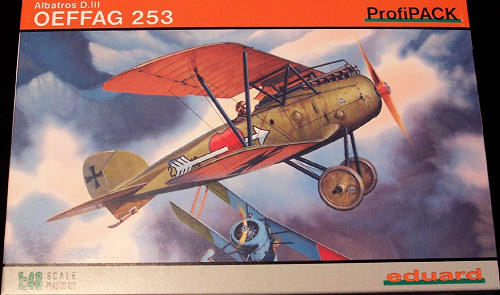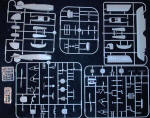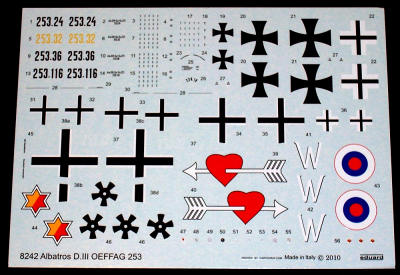
Eduard 1/48 Albatros D.III Oeffag 253
| KIT #: | 8242 |
| PRICE: | $34.95 MSRP, $29.95 at Earl's Hobby Hangar |
| DECALS: | Five options |
| REVIEWER: | Kyle Bodily |
| NOTES: |

| HISTORY |
After its success on the Western Front the Austro-Hungarian Empire
decided to start building the Albatros D.
The reason that they didn’t start out building the D.
Oeffag felt that
they could build a better wing and they did. In fact the argument can be made
that they built a better Albatros, even better then the original German built
versions.
The Austro-Hungarian pilots and even Americans of the Polish 7th
Air Escadrille who flew them in the Polish–Soviet war had no problems with the
Oeffag Albatros wings.
The series 53 and
53.2 all had the 185hp Austro-Daimler engine.
The series 153 was fitted with a 200hp engine.
Because of the excellent design changes that Oeffag had
incorporated in to airframe the aircraft needed little modification to accept
the new more powerful engine. This modification bumped up the max airspeed from
112 mph in the series 53/53.2 to 117 mph in the series 153.
The series 253 had the 225 hp Austro-Daimler that pushed its maximum
speed up to 125 mph. So we have a fighter that is not as fast as a Spad or SE5
but is easily more maneuverable than both and an aircraft that, while is not as
maneuverable as a Sopwith Camel, can easily outrun one. With qualities like this
it is easy to see why the aircraft was universally liked by the pilots who flew
them.
Several Oeffag
Albatros series 253s were built after World War one.
| THE KIT |
 This
is an all new kit and like all of Eduard’s new kits it is of the ProfiPACK
verity.
This
is an all new kit and like all of Eduard’s new kits it is of the ProfiPACK
verity.
The first thing that caught my eye was that you have all the parts to
build the whole Oeffag Albatros D.
The kit consists of
over one hundred plastic and metal parts and enough decals for five decal
options.
The parts look really nice and match up spot on with the drawings in the
book Austro-Hungarian Army Aircraft of World War One.
The fabric detail looks good except for that really high ribtaping that
Eduard has done ever since their Fokker D.
The cockpit looks
wonderful.
The Oeffag Albatros looked very different from the German
aircraft here and Eduard has done an excellent job with it.
The Austro-Daimler
engine here is quit well represented here.
This engine differed from the German Daimlers by having
the overhead cam timing shaft run up in front of the cylinders instead of
behind.
This is what gives the Austro-Daimler what I think is its most
distinctive feature and that is the large round access cover plate with the
Austro-Daimler logo.
Eduard gives you this very distinctive part in
photo-etch but alas they don’t have the Austro-Daimler logo on this part, darn
it, and it would have looked so cool as a photo-etch part.
 Moving on to
the 8mm Schwarzlose machine guns.
The 8mm Schwarzlose M.7/12 was by far the most common
machine gun in use by the Austro-Hungarian Empire Many companies building A-H
subjects model Spandau
Moving on to
the 8mm Schwarzlose machine guns.
The 8mm Schwarzlose M.7/12 was by far the most common
machine gun in use by the Austro-Hungarian Empire Many companies building A-H
subjects model Spandau
A few more of the
extras that you get with the kit are the two types of foredecking to allow you
to mount the guns ether buried or exposed.
Two types of winter cowlings one is for the buried and
the other for the exposed gun configuration.
Two propellers including the JARAY type, a very commonly
seen type on late war A-H aircraft.
Finely the builder will like the ability to chose from
strait or scalloped control surfaces
| CONCLUSIONS |
Well as I see it the big decision here is if you will want to build the
kit out of the box or blaze your own trail and build one of the many other
series and or your favorite pilots livery.
The kit is a great
addition to any WWI collection.
Eduard kits are about as strait forward and easy as WWI
kits get.
I recommend this kit
to any one with a passion for aircraft used by the dual monarchy.
I myself will probably do several and of course one will
be painted up in the famous Kosciuzko Squadron livery.
Review kit courtesy of
Earls Hobby Hangar
| REFERENCES |
“Austro-Hungarian Army Aircraft of World War One”, by Peter M. Grosz,
George Haddow and Peter Schiemer
“Air Aces of the Austro-Hungarian Empire 1914-1918”, by the late Dr.
Martin O’Conner
“Austro-Hungarian Aces of World War 1”, by Christopher Chant Osprey
Aircraft of the Aces #46
“Albatros (OEF) D.
Ausgust 2010
If you would like your product reviewed fairly and quickly, please contact me or see other details in the Note to Contributors.